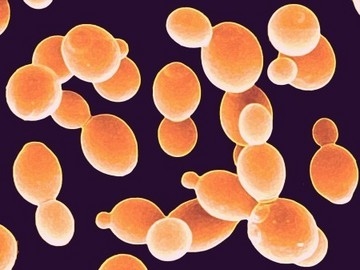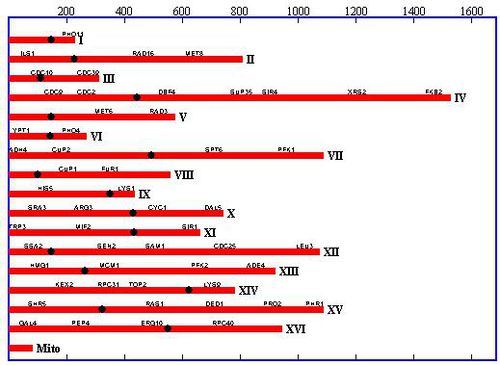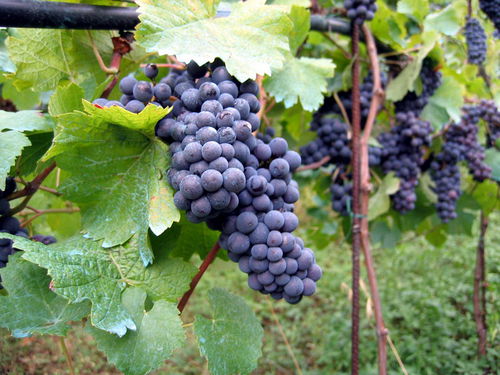Saccharomyces cerevisiae NEU2011: Difference between revisions
No edit summary |
No edit summary |
||
| Line 60: | Line 60: | ||
==Ecology== | ==Ecology== | ||
[[Image:Vineyard grape.jpg|thumb|500px|alt=Alt| ''Vineyard Grapes: A commong habitat for S. cerevisiae'' [http://blogs.bootsnall.com/llew/i-only-wait-so-long-between-updates-to-keep-you-eager-for-more.html | [[Image:Vineyard grape.jpg|thumb|500px|alt=Alt| ''Vineyard Grapes: A commong habitat for S. cerevisiae'' [http://blogs.bootsnall.com/llew/i-only-wait-so-long-between-updates-to-keep-you-eager-for-more.html 18]]] | ||
Due to its extensive use in human applications such as brewing, baking, distilling, and winemaking, it was once argued that there were no longer any wild strains of S. cerevisiae in nature [http://www.springerlink.com/content/wq8098830028j060/fulltext.pdf 9]. This is because the extent of what was known about the natural habitat of S. cerevisiae seemed to be limited to fruit fermentation in vineyards. If any wild strains did exist outside of these domestic environments, it was thought that they had evolved from the domestic strain, instead of the other way around [http://www.springerlink.com/content/wq8098830028j060/fulltext.pdf 9]. However, these presumptions changed as more research was conducted. Today, strains of Saccharomyces yeast have been found in a broad range of habitats such as in the soil of oak trees in New England [http://www.ncbi.nlm.nih.gov/pubmed/12702333 10], in the Danube river of Europe [http://www.ncbi.nlm.nih.gov/pubmed/9298185 11], and amongst trees and fruits in Asia [http://www.oeb.harvard.edu/faculty/hartl/lab/publications/pdfs/Landry-06-MolEcol.pdf 3]. | Due to its extensive use in human applications such as brewing, baking, distilling, and winemaking, it was once argued that there were no longer any wild strains of S. cerevisiae in nature [http://www.springerlink.com/content/wq8098830028j060/fulltext.pdf 9]. This is because the extent of what was known about the natural habitat of S. cerevisiae seemed to be limited to fruit fermentation in vineyards. If any wild strains did exist outside of these domestic environments, it was thought that they had evolved from the domestic strain, instead of the other way around [http://www.springerlink.com/content/wq8098830028j060/fulltext.pdf 9]. However, these presumptions changed as more research was conducted. Today, strains of Saccharomyces yeast have been found in a broad range of habitats such as in the soil of oak trees in New England [http://www.ncbi.nlm.nih.gov/pubmed/12702333 10], in the Danube river of Europe [http://www.ncbi.nlm.nih.gov/pubmed/9298185 11], and amongst trees and fruits in Asia [http://www.oeb.harvard.edu/faculty/hartl/lab/publications/pdfs/Landry-06-MolEcol.pdf 3]. | ||
| Line 105: | Line 105: | ||
[13] [http://www.sciencemag.org/content/292/5516/504.full Pfeiffer, T., Shuster, S., and S. Bonhoeffer. “Cooperation and Competition in the Evolution of ATP-Producing Pathways.” Science 292.5516 (2001): 504-507. Web. 17 Mar 2011] | [13] [http://www.sciencemag.org/content/292/5516/504.full Pfeiffer, T., Shuster, S., and S. Bonhoeffer. “Cooperation and Competition in the Evolution of ATP-Producing Pathways.” Science 292.5516 (2001): 504-507. Web. 17 Mar 2011] | ||
[14] [http://onlinelibrary.wiley.com/doi/10.1111/j.1574-6976.2002.tb00613.x/full Klis F.M., Mol P., Hellingwerf K., Brul S."Dynamics of cell wall structure in Saccharomyces cerevisiae." FEMS Microbiology Reviews. 26.3 (2002): 239-256. Web. 15 Mar 2011] | |||
[15] [http://www.ncbi.nlm.nih.gov/pmc/articles/PMC2225019/pdf/689.pdf Vitols Ederhards, North, R.J., Linnane Anthony. "Studies on the oxidative metabolism of Saccharomyces cerevisiae." The Journal of Biophysical and Biochemical Cytology. 9 (1961): 689-699. Web. 15 Mar 2011] | |||
[16] [http://www.ncbi.nlm.nih.gov/pmc/articles/PMC1170304/ Lorenz, M.C., Heitman, J. "Yeast pseudohyphal growth is regulated by GPA2, a G protein alpha homolog." The EMBO Journal. 16.23 (1997): 7008-7018. Web. 14 Mar 2011] | |||
[17] [http://www.nature.com/embor/journal/v5/n5/full/7400132.html Otterstedt Karin, Christer Larsson, Bill Roslyn, Stahlberg Anders, Echard Boles, Hohmann Stephan, Gustafsson Lena. "Switching the mode of metabolism in the yeast Saccharomyces cerevisiae." The EMBO Reports. 5. (2004): 532-537. Web. 20 Mar 2011] | |||
<b>Edited by the NC State University MB 103 class of 2007.</b> | <b>Edited by the NC State University MB 103 class of 2007.</b> | ||
Revision as of 19:06, 27 March 2011
Template:Biorealm Genus Saccharomyces cerevisiae

Classification
Higher order taxa
Domain: Eukarya
Kingdom: Fungi
Subkingdom: Dikarya
Phylum: Ascomycota
Subphylum: Saccharomycotina
Class: Saccharomycetes
Order: Saccharomycetales
Family: Saccharomycetaceae
Genus: Saccharomyces
Species: Cerevisiae
Species
| Taxonomy of Saccharomyces cerevisiae |
Genus species
Description and significance
Saccharomyces cerevisiae is a single-celled Eukaryotic budding yeast belonging to the Ascomycetes, a highly diverse group of fungi. The average cell measures approximately 8 micrometers in diameter, and they typically display a round to ovoid morphology [4]. S. cerevisiae is an important model organism as it was the first Eukaryote to have its genome fully sequenced. (2)
The most important commercial use for S. cerevisiae would be in food production. In the presence of oxygen, yeast cells can reproduce and CO2 by ways of the Citric Acid Cycle. When oxygen is not abundant, S. cerevisiae can also metabolize and reproduce, resulting in CO2 and alcohol by ways of fermentative glycolysis [4]. Used as the primary fermenter in brewing and as a leavening agent in baking, S. cerevisiae ferments sugars into carbon dioxide and alcohol during the brewing and baking processes. Because of these functions, S. cerevisiae is commonly referred to as “Baker’s yeast” or “Brewer’s yeast”. Additionally, the genus name “Saccharomyces” is derived from Latinized Greek and translates to “Sugar Fungus” [2]. The utilization of S. cerevisiae can be dated back to 3150 BC, where strains have been isolated from jars of King Scorpion I 5.
In addition to brewing and breadmaking, Saccharomyces cerevisiae has many pharmaceutical functions. The genome can be engineered to overproduce certain metabolites and commercially important compounds for the use in pharmaceutical agents. Examples of drugs that S. cerevisiae can express compounds for include naringenin, coumarate, artemisinin, taxol, amorphadiene and vitamin C 8.
In nature, S. cerevisiae exists in dense populations where in areas where damaged fruits are located, such as vineyards and fruit farms. S. cerevisiae has additionally been isolated from habitats such as soil, in rivers, and even in the human immune system. It can primarily be found in sugar rich environments, which are ideal for fermentation and reproduction. 3
S. cerevisiae can exist in several different strains. S288c was the first “modern” form of this yeast to be developed in a laboratory setting by Dr. Robert Mortimer the 1950s. As opposed to previously studied strains of yeast, this strain was heterothallic, meaning that the species has different sexes that occur in different individuals, and was therefore adopted as a useful model organism for recombinant research. 3 The S288c strain was later used to isolate other strains of S. cereviae in nature. In order to develop this particular strain, Dr. Mortier performed cross breeding of another heterothallic strain called EM93 that was isolated from rotten figs by Dr. Emil Mrak 3.
Genome structure

In 1996, Saccromyces cerevisiae was the first Eukaryote to have its genome completely sequenced by a team of over 600 scientists worldwide 5. As of that time, it was the largest genome to be sequenced to date. Because of this, the S. cerevisiae genome has been studied extensively and serves as a model organism for other genomic research. The genome consists of 16 chromosomes (8 pairs) in its haploid vegetative state. In nature, two of these haploid cells will fuse to form a diploid cell with 32 chromosomes (16 pairs). The haploid stage can exist in two forms, α and a, and two cells of the opposite form will fuse to form the diploid cell. S. cerevisiae haploid cells have the ability to switch between the two haploid mating types. The MAT, aka mating type, operon on the S. cerevisiae genome determines which mating type will be expressed. This mating process can produce great genetic variability from generation to generation [4].
When the genome was originally sequenced, it was assumed that all open reading frames longer than 100 codons would code for a protein. In the 15 years to follow, that hypothesis has been continually tested and the genome itself has been updated to contain 522 new ORFs that the originally sequenced genome did not account for 7. On February 2, 2011, an updated release of the S. cerevisiae genome was released 6. This data shows that 70% of the 12,157 kilobase S. cerevisiae genome encodes a protein. This amounts to 4,902 verified open reading frames. In addition to this, 27 genes are known to encode for rRNA, 6 encode for snRNA, and 299 encode for tRNA. This RNA encoding genes are scattered throughout the 16 chromosomes. The updated version of the genome, which can be found at yeastgenome.org, was sequenced using modern Illumina HiSeq, which outdates the Sanger sequencing methods used in 1996. The complete genomes of all major lab strains of S. cerevisiae are expected in the near future using the modern methods.
Cell structure, Metabolism & Life Cycle

Saccharomyces cerevisiae is a eukaryotic yeast that consists of a single cell, which is either round or ovoid and approximately 4-10 micrometers. The diploid variant is about 5-6 micrometers and is ovoid-shaped. When the diploid cells lack the necessary amounts of nitrogen, psuedohyphal growth may occur under direction of theheterotrimeric G protein alpha hamolog, GPA2 16.
S. cerevisiae has a cell wall composed of two layers, which are made up of mostly polysaccharides, but it is also contain lipids and proteins 15. The inner layer provides mechanical strength to the wall and supplies attachment sites for the proteins that form the outer layer. The inner layer is very strong because it is composed of β1,3-glucan and chitin. Exterior to the inner layer is the outer cell wall which provides osmotic and physical protection to the cell. The outer layer is composed of glycosylated mannoproteins that originate from the surface of the cell. These mannoproteins limit the ability of foreign enzymes to access the inner layer of the cell. The β1,3-glucan complexes have extensive branching, which further explains the strength of the cell wall. The cell wall is about 300 nanometers thick, and is smooth with the exception of bud scars, which forms on the mother cell after a daughter cell buds off. Other essential organelles to the cell include the nucleus, vacuoles, endoplasmic reticulum, and the mitochondria 14.
An integral characteristic of S. cerevisiae is that it is able to utilize two different metabolic pathways: aerobic respiration and anaerobic fermentation. S. cerevisiae is considered a heterotrophic organism because it breaks down carbohydrates to use as energy 17. S. cerevisiae performs respiration or fermentation depending on the presence or absence of oxygen (4). When undergoing respiration, S. cerevisiae completely reduces pyruvate to carbon dioxide, utilizing oxygen as the final electron accpetor. This provides the organism with the largest amount of ATP. When S. cerevisiae undergoes anaerobic respiration, glucose is fermented to produce ethanol 17. Fermentation will only occur under anoxic conditions because respiration yields much more energy per glucose than does fermentation (4) Fermentation produces carbon dioxide and ethanol, which explain the carbonation and alcohol found in beer 17.
The life cycle of S. cerevisiae has not yet been studied in nature, however it has been extensively studied in a laboratory setting. The life cycle begins as a unicellular diploid that reproduces through budding. Under times of environmental stress, meiosis occurs and results in four haploid spores. These spores are called ascus. The haploid spores can be one of two “mating types”, a or α, which is determined by the MAT genetic locus. The combination of two asci of different mating types will result in a diploid vegetative cell. S. cerevisiae also has an HO gene, which allows asci to switch mating types. Strains with this gene are referred to as homothallic. As a result of this, a mother cell can switch mating types and fuse with the daughter cell after division. This inbreeding can result in a loss of heterozygosity 3.
Ecology

Due to its extensive use in human applications such as brewing, baking, distilling, and winemaking, it was once argued that there were no longer any wild strains of S. cerevisiae in nature 9. This is because the extent of what was known about the natural habitat of S. cerevisiae seemed to be limited to fruit fermentation in vineyards. If any wild strains did exist outside of these domestic environments, it was thought that they had evolved from the domestic strain, instead of the other way around 9. However, these presumptions changed as more research was conducted. Today, strains of Saccharomyces yeast have been found in a broad range of habitats such as in the soil of oak trees in New England 10, in the Danube river of Europe 11, and amongst trees and fruits in Asia 3.
Although found in a variety of habitats, the most is known about the role of S. cerevisiae in the vineyard. In this environment they thrive on damaged grapes where they can carry out fermentation of the fruit sugars into ethanol and CO2. Fermentation is a very rapid and efficient process in Saccharomyces and has been shown to produce as much ATP per second as aerobic metabolism in other species 13. Ethanol fermentation is not unique to S. cerevisiae, however its ability ferment at such a rapid pace in the harsh grape environment is. Grape juice is very acidic with a pH between 2.5 and 3.8 caysed by tartrate, lactate, and malate acids. There is also a very high osmotic pressure because of the high sugar content in the environment. In addition, grapes grow best in environments with a range of temperatures and humidity levels so S. cerevisiae must be tolerant these fluctuations. Nitrogen and oxygen are also very scarce. The combination of these factors (high acidity, high osmotic pressure, anaerobic, and temperate variation) make it hard for any other organism to compete with S. cerevisiae in this environment once fermentation has begun. In addition, S. cerevisiae has a much higher tolerance to ethanol concentrations in the environment so their fermentation can actually kill off other species 3.
Yeast also has a competitive advantage in vineyards because it has been shown to produce a toxin that is lethal to other bacteria and more sensitive yeast species. Because of this quality, S. cerevisiae is classified in a group called “Killer yeasts”4. This “killer” quality is most advantageous in a setting that is very dense with other organisms, however they have been shown to ferment and grow more slowly once in isolation. The toxins created by these yeast cells resemble viruses that damage the plasma membrane of neighboring cells 12.
Since S. cerevisiae has such a tight relationship with human industry, it is thought that its genetics and geographic distribution have been greatly altered from the wildtype over time. However, S. cerevisiae has a very closely related sister species, S. paradoxus, which has little to no association with human influences. These two species are estimated to have diverged from a common ancestor 5-10 million years ago and are nearly phenotypically identical. Therefore, scientists often look to this species as a model ecological organism while looking to S. cerevisiae as a model genetic organism 12.
Pathogenicity
Current Research
Summarize at least two research articles
Cool factor
Describe in detail one particularly interesting aspect of your organism or it's affect on humans or the environment.
References
[2] White, Chris, and Jamil Zainasheff. Yeast: the Practical Guide to Beer Fermentation. Boulder, CO: Brewers Publications, 2010. Print.
[4] Madigan, Michael T. et al, 2009, Brock Biology of Microorganisms, San Francisco, CA, Pearson Education, Inc. Print.
[6] Saccharomyces Genome Database. 18 Feb. 2011. Web. 21 Feb. 2011. <http://www.yeastgenome.org/>.
Edited by the NC State University MB 103 class of 2007.
